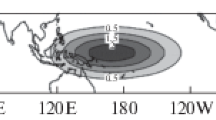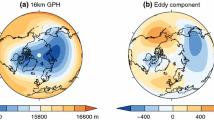Abstract.
The coupling between the stratosphere and the troposphere has been investigated by analysing low-frequency variations in: (1) the meridional mass flux into the polar cap (north of 60°N), computed separately for the stratosphere and the troposphere; (2) the polar cap mean surface pressure, and (3) the surface level meridional pressure gradient and zonal wind around 60°N. The analysis has been done for the 1979–93 Northern Hemisphere (NH) winters, using ECMWF reanalysis data. The results show that for all winters the meridional mass flux variations in the stratosphere precede those in the troposphere, by about one day. This result can also be obtained qualitatively with a very simple model, based on the zonally averaged zonal and meridional momentum equations. The lag is not very sensitive to the latitude of the southern boundary of the polar cap. The analysed variations in the polar cap mean surface pressure associated with variations in the meridional mass flux, determine most of the variability in the analysed meridional surface pressure gradient and the associated surface zonal wind around 60°N. The results also show that in the stratosphere the Coriolis force associated with the zonal-mean meridional wind is in near-balance with the convergence of the eddy momentum flux, and in the lower troposphere with the zonal frictional force. In summary, the results indicate that in the extratropical northern winter hemisphere, low-frequency variations in the meridional wind in the stratosphere induce low-frequency variations in the zonal wind near the surface.







Similar content being viewed by others
References
Baldwin MP, Dunkerton TJ (1999) Propagation of the Arctic Oscillation from the stratosphere to the troposphere. J Geophys Res 104: 30,937–30,946
Baldwin MP, Dunkerton TJ (2001) Stratospheric harbingers of anomalous weather regimes. Science 294: 581–584
Black RX (2002) Stratospheric forcing of surface climate in the Arctic Oscillation. J Clim 15: 268–277
Charney JG, Drazin PG (1961) Propagation of planetary-scale disturbances from the lower into the upper atmosphere. J Geophys Res 66: 83–109
Christiansen B (1999) Stratospheric vacillations in a general circulation model. J Geophys Res 56: 1858–1872
Christiansen B (2001) Downward propagation from the stratosphere to the troposphere: model and reanalysis. J Geophys Res 106: 27,307–27,322
Gibson JK, Kallberg P, Uppala S, Hernandez A, Normura A, Serran E (1997) ERA description, ECMWF Re-Analysis Project Report Series 1, ECMWF Reading RG2 AX, UK, pp 72
Hartley DE, Villarin J, Black RX, Davis CA (1998) A new perspective on the dynamical link between the stratosphere and troposphere. Nature 391: 471–474
Hartmann DL, Wallace JM, Limpasuvan V, Thompson DWJ, Holton JR (2000) Can ozone depletion and global warming interact to produce rapid climate change? Proc Natl Acad Sci 97: 1412–1417
Haynes PH, Shepherd TG (1989) The importance of surface pressure changes in the response of the atmosphere to zonally symmetric thermal and mechanical forcing. Q J R Meteorol Soc 115: 1181–1208
Haynes PH, Marks CJ, McIntyre ME, Shepherd TG, Shine KP (1991) On the "downward control" of extratropical diabatic circulation by eddy-induced mean zonal forces. J Atmos Sci 48: 651–678
Hoinka KP (1998) Statistics of the global tropopause pressure. Mon Weather Rev 126: 3303–3325
Holton JR (1992) An introduction to dynamic meteorology, 3rd Edn. Academic Press, San Diego, pp 511
Kodera K, Yamazaki K, Chiba M, Shibata K (1990) Downward propagation of upper stratospheric mean zonal wind perturbation to the troposphere. Geophys Res Lett 17: 1264–1266
Kuroda Y, Kodera K (1999) Role of planetary waves in the stratosphere–troposphere coupled variability in the northern hemisphere winter. Geophys Res Lett 26: 2375–2378
Matsuno T (1970) Vertical propagation of stationary planetary waves in the winter Northern Hemisphere. J Atmos Sci 27: 871–883
Peixoto JP, Oort AH (1992) Physics of climate. Springer, New York Berlin Heidelberg, pp 520
Shindell DT, Schmidt GA, Miller RL, Rind D (2001) Northern Hemisphere winter climate response to greenhouse gas, ozone, solar and volcanic forcing. J Geophys Res 106: 7193–7210
Thompson DWJ, Wallace JM (1998) The Arctic Oscillation signature in the wintertime geopotential height and temperature fields. Geophys Res Lett 25: 1297–1300
Trenberth KE (1991) Climate diagnostics from global analyses: conservation of mass in ECMWF analyses. J Clim 4: 707–722
Acknowledgements.
We thank Peter van Velthoven for helpful suggestions. Comments of two anonymous reviewers helped improve the manuscript, and are greatly appreciated.
Author information
Authors and Affiliations
Corresponding author
Appendix 1
Appendix 1
1.1 A simple model of the upper and lower level meridional flow
A very simple model of the lag between the upper level and lower level meridional transport as diagnosed in Sect. 3.2, is presented. The atmosphere is separated into an upper layer (index 1) and a lower layer (index 2), and in a region a from 60–90°N and a region b south of 60°N, with the same area as region a. For simplicity it is assumed that both layers have equal pressure thickness Δp. The model consists of simplified versions of the zonally averaged zonal and meridional momentum equations (see e.g. Holton 1992, p. 316), applied to lower layer 2. The zonal momentum equation is approximated as a balance between the Coriolis force on the zonal-mean meridional wind and the frictional force:
where the second part of Eq. (7) expresses the approximation of F f in terms of the zonal-mean zonal wind [u 2]; k is a constant of proportionality (it would be more realistic to express the friction in terms of [u 2]2 rather than [u 2], but for reasons of simplicity a linear relation is assumed). In Eq. (7) the zonal wind tendency and the convergence of the eddy momentum flux have been neglected, which is supported by the results at the end of Subsect. 3.4. The meridional momentum equation is approximated by a balance between the meridional surface pressure gradient force and the Coriolis force on the zonal-mean zonal wind:
where ρ denotes density and Y, the length scale for this gradient, is taken as the distance between the two latitudes which separate, respectively, regions a and b in two equal-area parts; p 0a and p 0b denote the area mean surface pressure in, respectively, region a and b. More precisely, [u 2] is balanced by the mean pressure gradient in layer 2 rather than by the surface pressure gradient. The mean pressure gradient is determined by the surface pressure gradient as well as by the temperature difference between regions a and b. However, as mentioned below, in this model it are the pressure time variations rather than the pressure itself that are relevant. In the model, variations in temperature are not considered and, therefore, the variations in the pressure gradient are approximated by the variations in the surface pressure gradient.
Further, under the assumptions of hydrostatic equilibrium and that there is no mass flux across the southern boundary of region b, the conservation of mass implies that the surface pressure tendencies in the equal areas a and b can be expressed as:
where
and a is the radius of the Earth. Combining Eqs. (7) and (8) into one equation for [v 2] and substituting the time-derivative of the resulting equation into Eq. (9), gives an expression relating [v 1] and [v 2]:
where the time constant τ is equal to (ρY f 2 d)/(2 k ΔP). The value of k is estimated from Eq. (7), assuming that [v 2]/[u 2] = 0.1, and f is computed at 60°N. Adopting Δp = 500 hPa and ρ = 1 kg/m3, and computing Y and d as described above, a value for τ of 0.4 day is obtained. To determine the lag between [v 1] and [v 2], the [v 1] is assumed to vary harmonically with time with a period T, i.e. [v 1] = v 10 cos(2πt/T). For reasons of simplicity, the attention here is restricted to oscillations for which T is much larger than 2πτ. This applies to a large part of the variations of the 11-day running mean filtered data of this study. For these oscillations, the solution of Eq. (10) is [v 2] = –v 10 cos(2π(t – τ)/T). Thus, [v 2] lags [v 1] by a period τ.
The lag time between [v 1] and [v 2] as diagnosed in Sect. 3 is about 0.8 day. Although this value is twice the value estimated with this very simple model, it nevertheless indicates that the lag between [v 1] and [v 2] can, at least qualitatively, be described by two balances of forces, namely in the zonal direction a balance between the Coriolis force on the zonal-mean meridional wind and the frictional force on the zonal-mean zonal wind (Eq. (7)), and in the meridional direction a geostrophic balance (Eq. (8)).
It should be noted that the stratospheric wave forcing, which determines the meridional mass flux variations in the upper layer 1, is not considered in this model. In the model the latter variations are prescribed, rather than modelled as a response to wave forcing, and the response of only the meridional mass flux in the lower layer 2 is calculated.
Rights and permissions
About this article
Cite this article
Sigmond, M., Siegmund, P.C. & Kelder, H. Analysis of the coupling between the stratospheric meridional wind and the surface level zonal wind during 1979–93 Northern Hemisphere extratropical winters. Climate Dynamics 21, 211–219 (2003). https://doi.org/10.1007/s00382-003-0328-2
Received:
Accepted:
Published:
Issue Date:
DOI: https://doi.org/10.1007/s00382-003-0328-2




